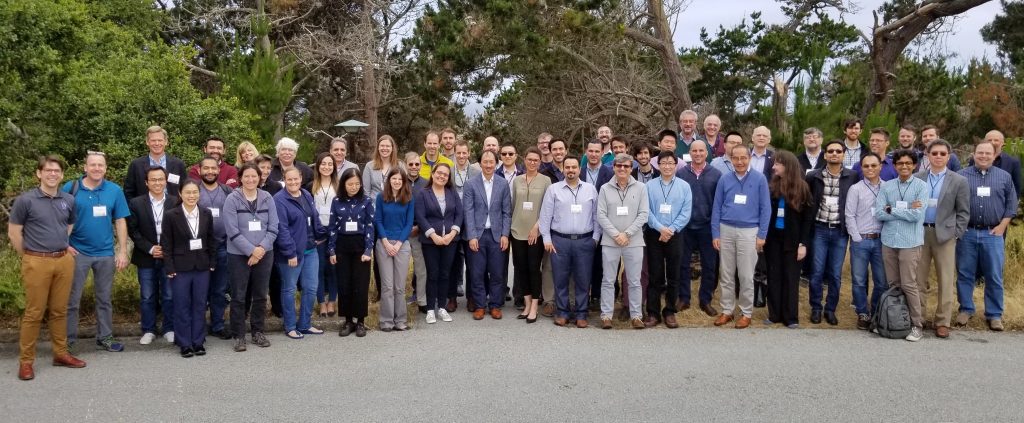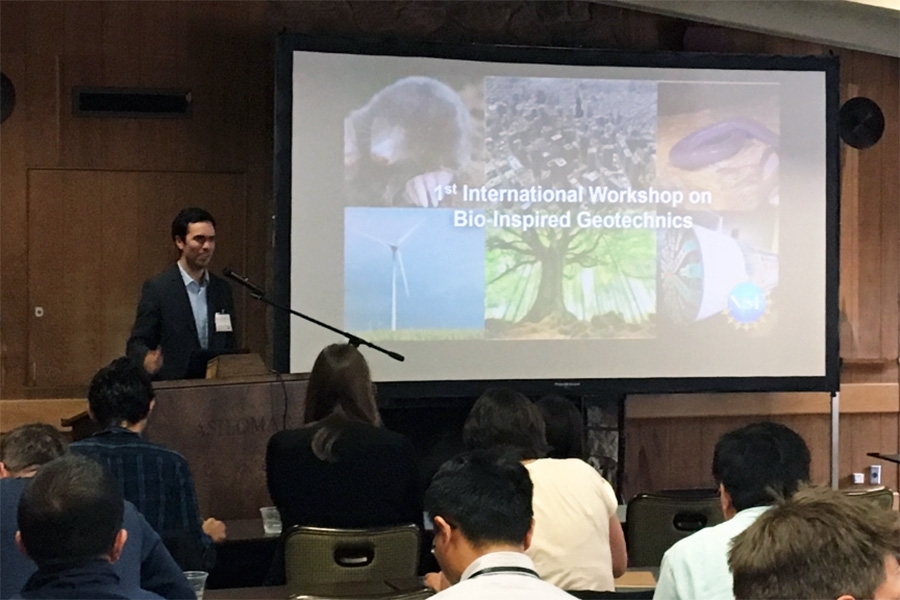 Alejandro Martinez welcomes engineers, biologists, physicists and others to the First International Workshop on Bio-Inspired Geotechnics in May at the University of California, Davis. The unique gathering aimed to better define the emerging field of bio-inspired geotechnics and connect researchers from a broad range of disciplines to collaborate on groundbreaking ideas in the area. Martinez, who earned his Ph.D. in civil engineering at Georgia Tech in 2015, is now an assistant professor at UC Davis and one of two lead organizers for the workshop. The other, Jason DeJong, also earned his civil engineering doctorate at Tech. (Photo: Noah Pflueger-Peters/UC Davis) |
By Noah Pflueger-Peters, UC Davis College of Engineering
A melting pot of experts with research interests as diverse as geotechnical engineering, termite burrowing, tree physiology, granular physics and soft robotics trickled in from around the world in late May for the First International Workshop on Bio-Inspired Geotechnics.
The NSF-funded workshop, the product of a year and a half of planning by UC Davis civil and environmental engineering professors Alejandro Martinez and Jason DeJong, brought together 60 experts from engineering and science research, as well as industry, to foster dialogue and collaborations to better establish the field of bio-inspired geotechnics.
“I think everyone was really excited to be in a room with people who they would’ve never talked to otherwise,” Martinez said. “The event may have opened the door for interactions between people who had never talked to a geotechnical engineer or a biologist before.”
Martinez and DeJong both earned their doctorates in civil engineering at Georgia Tech. They worked with Elizabeth and Bill Higginbotham Professor David Frost on textured subsurface probes that are central to several projects in bio-inspired geotechnics.
Frost and School of Civil and Environmental Engineering faculty members Chloe Arson and Sheng Dai were among the workshop’s participants, along with Tech researchers from physics, biology and computing. All are involved in the NSF-supported Center for Bio-Mediated and Bio-Inspired Geotechnics, which Frost helps lead.
Inspired by biology
Bio-inspired geotechnics turns to biology for inspiration to solve problems in geotechnical engineering. Studying the ground is no easy task — geotechnical engineers have to account for the extreme variability of soil conditions to make sure that infrastructure is safe, even during extreme events like powerful earthquakes. Building underground involves even more challenges, including drilling through hard and variable terrain and building structures that are difficult to access later for repairs or rescue, if necessary.
Nature has already developed ways of dealing with these problems, as evidenced by animals and plants that burrow extremely efficiently in the soil. If geotechnical engineers, biologists and roboticists can work together, they can create biology-inspired stabilizing systems, sensors and geologic exploration methods to effectively design, build and maintain modern infrastructure.
 Group photo of attendees at the First International Workshop on Bio-Inspired Geotechnics. (Photo Courtesy: Alejandro Martinez) |
At the intersection of science and engineering
Over three days, workshop attendees broke into diverse working groups to solve real-world problems and were treated to lectures from experts in each field that explained cutting-edge developments — and challenges — in their fields.
“I’ve found the interaction between engineers and scientists to be really beneficial,” Martinez said. “We have very different ways of addressing problems. Constant contact with the other side brings a better perspective.”
“It feels momentous,” said Matt Burrall, a Ph.D. student working under Jason DeJong at UC Davis. “It’s an excellent opportunity to hear about things that you would generally not be in the right place or the right time to hear.”
A developing field
The field of bio-inspired geotechnics has existed for less than a decade. The first paper referencing the idea was published in 2010; just five years later, the NSF funded the Center for Bio-Mediated and Bio-Inspired Geotechnics. Already, the center has produced more than 150 publications and involves 30 faculty and 50 graduate students across its partner institutions —Arizona State University, Georgia Tech, New Mexico State and UC Davis.
The newness of the field also means that there are challenges to be overcome, like a lack of common vocabulary and no solid definition of what “bio-inspired geotechnics” really means. This is crucial not only for collaborating between fields, but also in training new faculty and students interested in bio-inspired geotechnics. The last day of the workshop was spent brainstorming this issue, as well as how to fund proposals.
The workshop will culminate in a journal paper co-authored by all the attendees that summarizes the workshop’s achievements for a geotechnical engineering audience. The biology attendees also are planning a similar paper for a biology magazine from their perspective.
“Bring this diverse group of people together for a few days to explore what the future of bio-inspired geotechnics was an experiment in itself,” DeJong said. “It was very stimulating and enjoyable, so I’d say it points toward promising future.”
Related
- Center for Bio-Mediated and Bio-Inspired Geotechnics
- News: “Using nature’s roadmap: Frost helps lead new NSF center that could change the face of geotechnical engineering”
- David Frost

